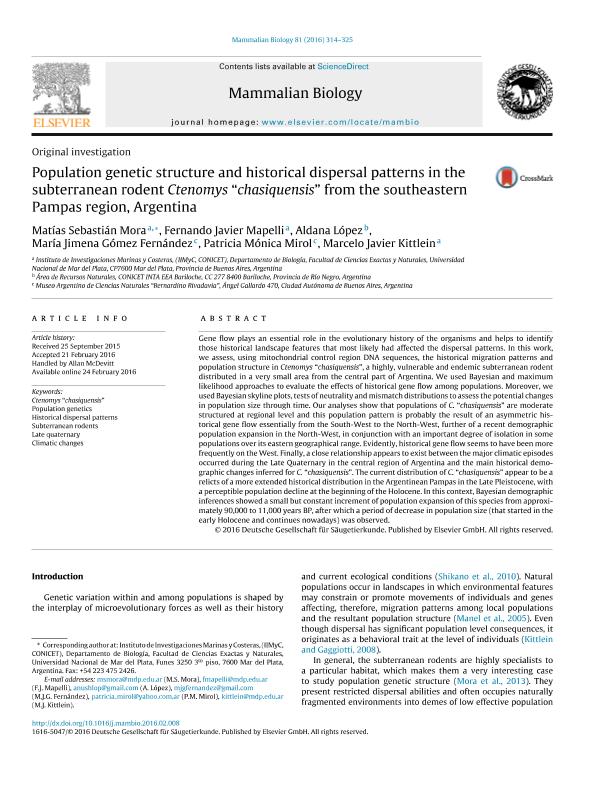Mostrar el registro sencillo del ítem
dc.contributor.author
Mora, Matias Sebastian

dc.contributor.author
Mapelli, Fernando Javier

dc.contributor.author
López, Aldana Soledad

dc.contributor.author
Gomez Fernandez, Maria Jimena

dc.contributor.author
Mirol, Patricia Monica

dc.contributor.author
Kittlein, Marcelo Javier

dc.date.available
2018-05-30T16:51:23Z
dc.date.issued
2016-05
dc.identifier.citation
Mora, Matias Sebastian; Mapelli, Fernando Javier; López, Aldana Soledad; Gomez Fernandez, Maria Jimena; Mirol, Patricia Monica; et al.; Population genetic structure and historical dispersal patterns in the subterranean rodent Ctenomys “chasiquensis” from the southeastern Pampas region, Argentina; Elsevier Gmbh; Mammalian Biology; 81; 3; 5-2016; 314-325
dc.identifier.issn
1616-5047
dc.identifier.uri
http://hdl.handle.net/11336/46633
dc.description.abstract
Gene flow plays an essential role in the evolutionary history of the organisms and helps to identify those historical landscape features that most likely had affected the dispersal patterns. In this work, we assess, using mitochondrial control region DNA sequences, the historical migration patterns and population structure in Ctenomys “chasiquensis”, a highly, vulnerable and endemic subterranean rodent distributed in a very small area from the central part of Argentina. We used Bayesian and maximum likelihood approaches to evaluate the effects of historical gene flow among populations. Moreover, we used Bayesian skyline plots, tests of neutrality and mismatch distributions to assess the potential changes in population size through time. Our analyses show that populations of C. “chasiquensis” are moderate structured at regional level and this population pattern is probably the result of an asymmetric historical gene flow essentially from the South-West to the North-West, further of a recent demographic population expansion in the North-West, in conjunction with an important degree of isolation in some populations over its eastern geographical range. Evidently, historical gene flow seems to have been more frequently on the West. Finally, a close relationship appears to exist between the major climatic episodes occurred during the Late Quaternary in the central region of Argentina and the main historical demographic changes inferred for C. “chasiquensis”. The current distribution of C. “chasiquensis” appear to be a relicts of a more extended historical distribution in the Argentinean Pampas in the Late Pleistocene, with a perceptible population decline at the beginning of the Holocene. In this context, Bayesian demographic inferences showed a small but constant increment of population expansion of this species from approximately 90,000 to 11,000 years BP, after which a period of decrease in population size (that started in the early Holocene and continues nowadays) was observed.
dc.format
application/pdf
dc.language.iso
eng
dc.publisher
Elsevier Gmbh

dc.rights
info:eu-repo/semantics/openAccess
dc.rights.uri
https://creativecommons.org/licenses/by-nc-sa/2.5/ar/
dc.subject
Ctenomys “Chasiquensis”
dc.subject
Population Genetics
dc.subject
Historical Dispersal Patterns
dc.subject
Subterranean Rodents
dc.subject
Late Quaternary
dc.subject
Climatic Changes
dc.subject.classification
Otras Ciencias Biológicas

dc.subject.classification
Ciencias Biológicas

dc.subject.classification
CIENCIAS NATURALES Y EXACTAS

dc.title
Population genetic structure and historical dispersal patterns in the subterranean rodent Ctenomys “chasiquensis” from the southeastern Pampas region, Argentina
dc.type
info:eu-repo/semantics/article
dc.type
info:ar-repo/semantics/artículo
dc.type
info:eu-repo/semantics/publishedVersion
dc.date.updated
2018-05-24T14:28:35Z
dc.journal.volume
81
dc.journal.number
3
dc.journal.pagination
314-325
dc.journal.pais
Alemania

dc.journal.ciudad
Jena
dc.description.fil
Fil: Mora, Matias Sebastian. Consejo Nacional de Investigaciones Científicas y Técnicas. Centro Científico Tecnológico Conicet - Mar del Plata. Instituto de Investigaciones Marinas y Costeras. Universidad Nacional de Mar del Plata. Facultad de Ciencia Exactas y Naturales. Instituto de Investigaciones Marinas y Costeras; Argentina
dc.description.fil
Fil: Mapelli, Fernando Javier. Consejo Nacional de Investigaciones Científicas y Técnicas. Centro Científico Tecnológico Conicet - Mar del Plata. Instituto de Investigaciones Marinas y Costeras. Universidad Nacional de Mar del Plata. Facultad de Ciencia Exactas y Naturales. Instituto de Investigaciones Marinas y Costeras; Argentina
dc.description.fil
Fil: López, Aldana Soledad. Consejo Nacional de Investigaciones Científicas y Técnicas; Argentina. Instituto Nacional de Tecnología Agropecuaria; Argentina
dc.description.fil
Fil: Gomez Fernandez, Maria Jimena. Consejo Nacional de Investigaciones Científicas y Técnicas. Oficina de Coordinación Administrativa Parque Centenario. Museo Argentino de Ciencias Naturales "Bernardino Rivadavia"; Argentina
dc.description.fil
Fil: Mirol, Patricia Monica. Consejo Nacional de Investigaciones Científicas y Técnicas. Oficina de Coordinación Administrativa Parque Centenario. Museo Argentino de Ciencias Naturales "Bernardino Rivadavia"; Argentina
dc.description.fil
Fil: Kittlein, Marcelo Javier. Consejo Nacional de Investigaciones Científicas y Técnicas. Centro Científico Tecnológico Conicet - Mar del Plata. Instituto de Investigaciones Marinas y Costeras. Universidad Nacional de Mar del Plata. Facultad de Ciencia Exactas y Naturales. Instituto de Investigaciones Marinas y Costeras; Argentina
dc.journal.title
Mammalian Biology

dc.relation.alternativeid
info:eu-repo/semantics/altIdentifier/doi/https://dx.doi.org/10.1016/j.mambio.2016.02.008
dc.relation.alternativeid
info:eu-repo/semantics/altIdentifier/url/https://www.sciencedirect.com/science/article/pii/S161650471630012X
Archivos asociados
